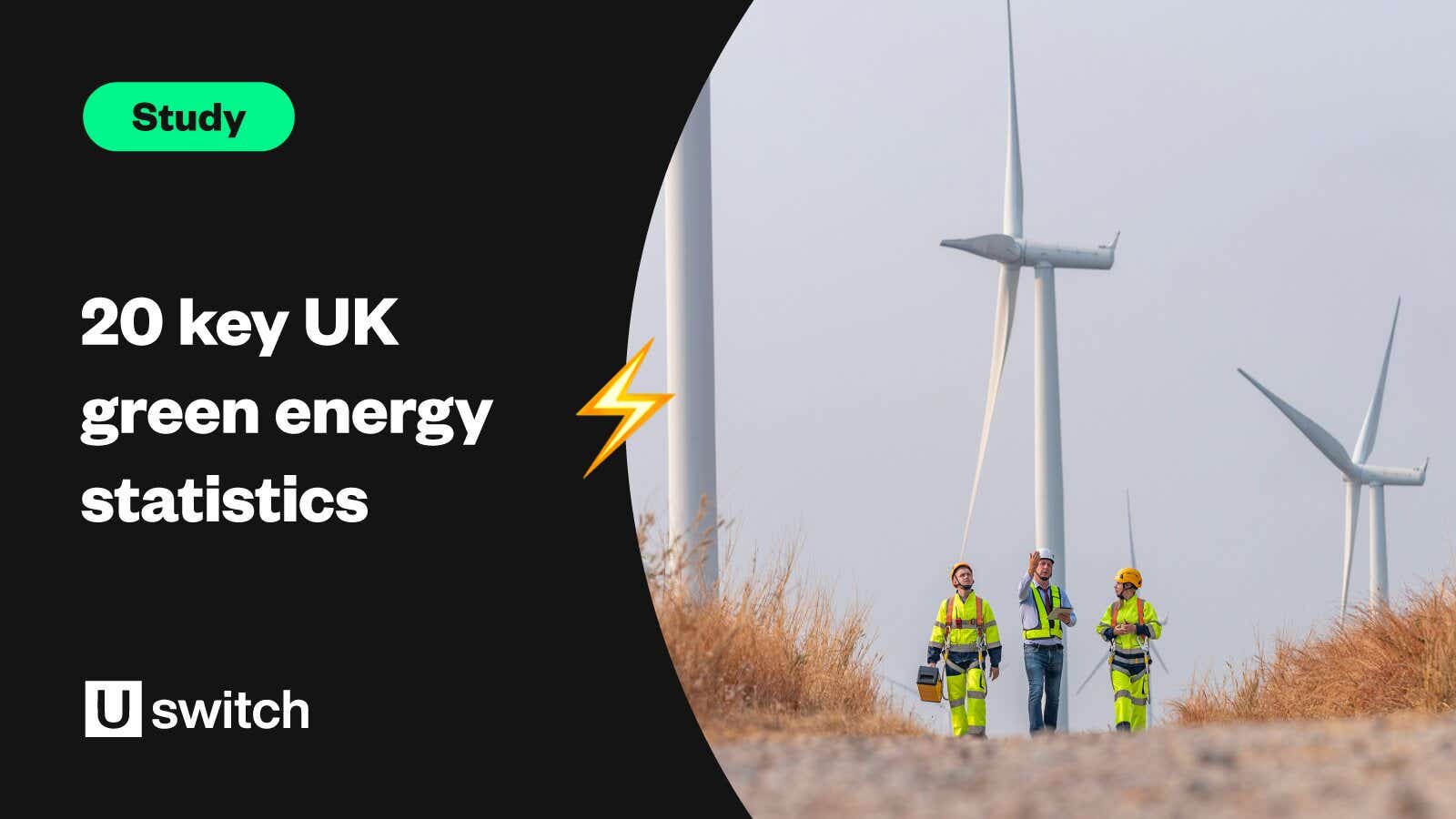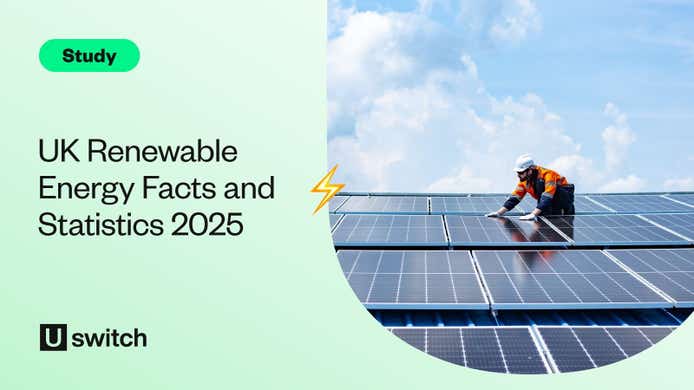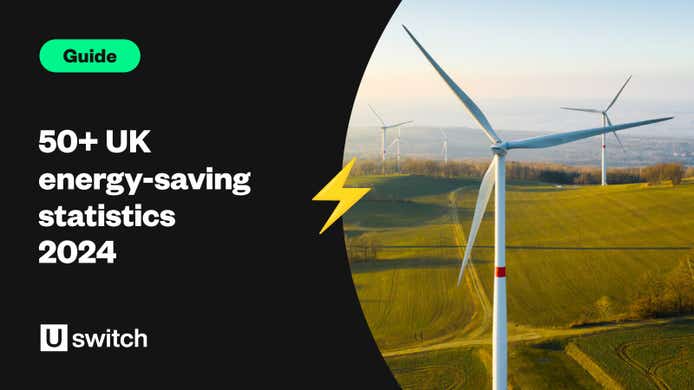As we aim for a net zero future, the topic of green energy becomes more prominent by the year. Whether it’s government plans to reduce carbon emissions or home renovations designed to lower your own footprint, green energy is playing an increasingly important part in all our lives.
This guide will highlight some of the key green energy affecting the UK today. Each one of our stats will offer key insight into the steps being taken as we move towards a more sustainable future.
1. How much of the UK's energy is green energy?
The UK’s overall green energy production reached 135 terawatt hours (TWh) in 2023, accounting for 47.3% of overall energy production. This was a 6.2% increase from 2022 (41.6%) and the highest figure on record.
By comparison, fossil fuels accounted for just over a third (36.4%) of overall energy production in 2023 – 10% less than green energy and the lowest figure on record.
Q4 2023 also marked the first time that green energy accounted for more than half of all energy production for a single quarter. With an overall share of 51.5%, this represented a 6.2% rise from the same quarter in 2022.
2. How much of the UK’s energy is generated by offshore wind?
Offshore wind-generated energy in the UK reached a record high of 49.5TWh in 2023. This accounted for just under a fifth (17.3%) of overall energy production in the UK – the highest percentage of any individual green energy source.
In Q4 2023, offshore wind accounted for more than a fifth of the UK’s energy production, at 20.9%. This was a 2.1% rise from the same period in 2022, marking the first quarter that an individual green energy source accounted for more than a fifth of UK energy production.
The green energy sources with the highest percentage of overall UK energy production (Q4 2022 to Q4 2023)
As we aim towards a net zero future, the topic of green energy becomes more prominent by the year. Whether it’s government plans to reduce carbon emissions or home renovations designed to lower your own footprint, green energy is playing an increasingly important part in all our lives.
This guide will highlight some of the key green energy affecting the UK today. Each one of our stats will offer key insight into the steps being taken as we move towards a more sustainable future.
1. How much of the UK's energy is green energy?
The UK’s overall green energy production reached 135 terawatt hours (TWh) in 2023, accounting for 47.3% of overall energy production. This was a 6.2% increase from 2022 (41.6%) and the highest figure on record.
By comparison, fossil fuels accounted for just over a third (36.4%) of overall energy production in 2023 – 10% less than green energy and the lowest figure on record.
Q4 2023 also marked the first time that green energy accounted for more than half of all energy production for a single quarter. With an overall share of 51.5%, this represented a 6.2% rise from the same quarter in 2022.
2. How much of the UK’s energy is generated by offshore wind?
Offshore wind-generated energy in the UK reached a record high of 49.5TWh in 2023. This accounted for just under a fifth (17.3%) of overall energy production in the UK – the highest percentage of any individual green energy source.
In Q4 2023, offshore wind accounted for more than a fifth of the UK’s energy production, at 20.9%. This was a 2.1% rise from the same period in 2022, marking the first quarter that an individual green energy source accounted for more than a fifth of UK energy production.
The green energy sources with the highest percentage of overall UK energy production (Q4 2022 to Q4 2023)

| Green energy source | Percentage of overall UK energy from this source in Q4 2022 | Percentage of overall UK energy from this source in Q4 2023 |
|---|---|---|
| Bioenergy | 9.9% | 12.7% |
| Offshore Wind | 18.8% | 20.9% |
| Onshore Wind | 12.3% | 13.3% |
| Solar PV | 2% | 2.3% |
| Hydro | 2.3% | 2.4% |
(Source: Gov.uk)
In the same quarter, onshore energy was responsible for 13.3% of UK energy production with bioenergy accounting for 12.7% – more than a quarter of UK energy combined.
3. How much is the UK investing in green energy?
There are few countries investing as much as the UK when it comes to transitioning to sustainable energy. In 2023, the UK spent £57.8 billion on energy transition investments – the fourth highest worldwide.
By comparison, this was a third (33%) more than France (£43.4 billion) and more than double (+131%) the investment of Japan (£25 billion).
The countries with the highest investment in energy transition (2023)

However, the UK still lagged behind the top two, China (£528.2 billion) and the US (£236.9 billion), which invested more than a trillion dollars combined. This meant the UK’s figures were around 89% less than China's and more than three-quarters (76%) lower than that of the US.
4. How much of the UK’s carbon emissions come from households?
A government report in February 2024 found that UK homes were responsible for more than a quarter (26%) of overall energy consumption in 2022, and produced nearly a fifth (17%) of overall CO2 emissions.
The percentage of UK household emissions by source

Natural gas was the biggest contributor to this total, accounting for nearly two-thirds (62%) of household energy consumption in the UK. This was followed by water and heating (18%), electrical appliances (14%), lighting and cooking (both 3%).
5. How much solar energy is produced in the UK?
As of January 2024, the UK’s total solar energy capacity stood at 15.7GW – a rise of 6.6% from the same time a year earlier. These rises are expected to climb further in the coming years with a further 58MW of solar PV capacity being installed around the UK in January 2024 alone.
Home installations were responsible for nearly three-tenths (29%) of the UK's total solar capacity and more than three-quarters of the new capacity (77%) added in January 2024.
6. Which industries produce the most emissions?
The energy industry leads the way for pollution in the UK, producing 37.5 billion tonnes of greenhouse gas (GHG) emissions annually. Transport is the next highest industry, with just under 7.3 billion GHG emissions – around 81% less than energy.
The top seven most polluting industries in the UK

Agriculture, along with manufacturing and construction, are the only other sectors producing more than five billion GHG emissions per year, with totals of 5.87 billion and 6.22 billion respectively.
7. How effective are green buildings?
A green energy report from Ruby Home estimated that converting to a green building reduces operation costs by an average of 10.5% in the first year.
This typically rises to 16.5% after five years, with owners reporting an average asset value increase of 9%.
8. How many jobs are created by green energy?
A 2024 report from the ONS found that there were around 640,000 full-time or equivalent (FTEs) green jobs in the UK as of 2022. This represented a rise of 8.4% from 2021 and around 20% from 2020.
The number of full-time equivalent (FTE) green jobs in the UK (2020-22)
| Year | Number of full-time or equivalent green jobs |
|---|---|
| 2020 | 522,200 |
| 2021 | 589,600 |
| 2022 | 639,400 |
(Source: ONS)
Energy-efficient products and waste were the two biggest green job sectors in 2022, with around 116,100 and 138,900 FTEs, respectively.
9. Can green energy create more jobs than fossil fuels?
A report published by the UK Energy Research Centre in 2022 found that renewable energy sources create more than three times as many jobs per million pounds invested as fossil fuels.
The estimated number of jobs created per million pounds invested by energy source

Fossil fuels were estimated to create three jobs for every million invested, compared to five for nuclear power (+66%) and ten for renewable energy (+233%). Jobs labelled as ‘energy efficiency’ created the highest number of jobs per million pounds invested, at 16 – more than five times more than fossil fuels.
10. Do fossil fuels get more government subsidies than green energy?
Despite the global coverage of the climate crisis, fossil fuels continue to receive more government subsidies than green energy. In 2022, global fossil fuel subsidies rose to a record £5.5 trillion – equivalent to 7.1% of the global gross domestic product (GDP).
In the same year, a report published in the Guardian found that the UK government had given £80 billion in subsidies to fossil fuels since 2015, compared to just £60 billion for renewable energy (-25%).
11. Are big businesses committed to net zero?
A report from Net Zero Tracker found that just over half (50.2%) of Forbes’ Global 2,000 companies were committed to a net zero target, as of November 2023. The number of companies on the list with net zero targets rose by more than 40% over 16 months, from 702 in June 2022 to 1,003 in October 2023.
The number of companies in the Forbes Global 2000 with net zero targets by month/year
| Month/year | Number of companies in Forbes Global 2000 with a Net Zero target | Percentage of companies in Forbes Global 2000 with a Net Zero target |
|---|---|---|
| June 2022 | 702 | 35.1% |
| November 2023 | 1,003 | 50.1% |
(Source: Zero Tracker)
This means that two-thirds (66%) of annual revenue from the world's largest 2,000 companies is covered by a net zero target, totalling approximately £21.1 trillion.
Despite this, around a third (33%) of the companies on the list are yet to set any type of emissions reduction target.
12. Are we on track to hit net zero?
In 2022, the global decarbonisation rate was just 2.5%, meaning that the world must decarbonise around seven times faster between 2023 and 2050 to meet the global targets for net zero.
13. How much of the world’s energy will be renewable by 2050?
As many of the world’s leading nations strive towards net zero targets, the International Energy Agency (IEA) estimates that 90% of the planet’s energy will be renewable by 2050, with solar PV and wind accounting for almost 70% combined.
14. How long has green energy been used?
The increasing coverage of green energy over the last few years can make it feel like a fairly new phenomenon. In reality, the use of renewable sources can be traced back as far as 2,000 years, with the invention of the water wheel.
Both the Ancient Greeks and the Romans were known to use water wheels for crop irrigation, grinding grains, and supplying drinking water to villages. The basic design and purpose of the water wheel provided the blueprint for the modern uses of hydropower energy we see today!

15. How many cities are reliant on green energy?
Of the 620 cities reporting to the Carbon Disclosure Project (CDP), nearly a fifth (16%) get at least 70% of their energy from renewable sources like hydro, geothermal, solar and wind.
This equates to over 100 cities, including the likes of Reykjavík and Basel, which operate on close to 100% renewable energy.

16. Which country uses the most green energy?
Iceland leads the way when it comes to renewable energy. In 2023, nearly nine-tenths (87%) of the energy generated in Iceland came from renewable sources – 5% more than any other country.
The countries with the highest percentage of energy generated from renewable sources

72% of Norway’s energy generation came from renewable sources – 21% more than any other country and the second highest overall. Norway was followed by Sweden (51%), which was the only other country that generated more than half of its electricity from renewable sources.
Rounding off the top five were Brazil and New Zealand, with rates of 46% and 40%, respectively.
17. Does the green energy sector employ more women than the fossil fuel industry?
As of 2022, nearly a third (32%) of all employees in the global renewable energy industry were women. This is 10% more than the fossil fuels sector, where only 22% of workers were women.
The percentage of female employees in the fossil fuels and renewable energy sectors

An article from Solar Power Europe claimed that solar energy employs the largest proportion of female workers at 40% – 15% more than fossil fuels.
18. What is the most widely used type of green energy globally?
Hydropower is the most used form of green energy globally. More than half (54%) of the world's renewable energy comes from hydropower, with hydro energy responsible for nearly a fifth (18%) of the world's total electricity.
19. How much energy is produced from the tide?
The total energy contained in the world’s tides is thought to be around 3,000GW. Although only 120GW to 400GW (4%-13%) is available for power generation, that’s enough to power between 12 billion and 40 billion lightbulbs.
20. How much bigger have wind turbines become?
The first-ever commercial offshore wind turbine was built by technology company Seimans in 1991. Installed in the Vindeby Offshore Wind Farm on the Danish island of Lolland, the turbine’s blades were just 5 metres long, creating 30 kilowatts of energy per hour.
By comparison, the latest turbines under the Siemens Gamesa brand have blades that are 108 metres long, with a 222-metre diameter rotor. Just one turbine can generate enough electricity to power roughly 18,000 homes per year, highlighting the huge leaps in wind energy technology over the last few decades!
FAQs
What is green energy?
Green energy refers to any type of energy derived from a natural source that won't run out (e.g. sun, light, and wind). Examples of green energy include wind turbines and solar panels.
Why are renewable energy sources important?
Renewable or green energy sources do not emit harmful greenhouse gases like fossil fuel-based sources such as oil, gas, and coal. As such, the widespread adoption of renewable sources will be key to combating the global environmental crisis and working towards a net-zero future.
What is net zero?
Net zero refers to the target of completely eliminating excess greenhouse gas emissions produced by humans. Net Zero will be achieved when the amount of carbon emitted into the atmosphere is no more than the amount being removed.
The global target to achieve net zero by 2050 aims to do this by replacing the use of traditional fossil fuels like oil and gas with 100% green energy sources.
What are the challenges of green energy in the UK?
One of the main challenges for developing green energy in the UK is its infrastructure. Much of the UK's national grid network is ageing, with some parts pre-dating the post-war era.
This system was designed for a one-way supply of energy from power plants to customers. Therefore, it may take significant time and expense to update the grid network in a way that successfully accommodates green energy.
Is a transition to 100% green energy possible?
Yes. Numerous recent reports and studies have shown that a transition to 100% renewable energy across all sectors is possible. The ability to achieve this will depend on an array of factors, including:
- Infrastructure developments
- Technology advancements
- Government commitments
- Funding
- Public compliance.
While we are still some way off achieving a global net zero, the reduction in carbon emissions in recent years has shown that we can significantly reduce reliance on non-renewable energy sources if we follow the right measures.
Can green energy run out?
Green energy refers to sources of energy that are either not depleted when used (e.g. wind and solar power) or sources that can be replenished (biomass). Therefore, green energy is entirely renewable and cannot run out in the same way that finite sources like oil and coal can.
Glossary
Gigawatt (GW)
A gigawatt is a unit of energy equivalent to one billion watts or 1,000 megawatts (MW).
Megawatt (MW)
A megawatt is a unit of energy equivalent to one million watts.
Terawatt Hours (TWh)
Terawatt hours is a unit of energy equivalent to one trillion watt-hours.
Methodology and sources
https://www.statista.com/statistics/1290974/investment-in-energy-transition-by-country/
https://www.lloydsbankinggroup.com/insights/decarbonising-the-uks-homes.htm
https://www.theecoexperts.co.uk/blog/top-7-most-polluting-industries
https://researchbriefings.files.parliament.uk/documents/CBP-9889/CBP-9889.pdf
https://www.brunel.net/en-au/blog/renewable-energy/fascinating-renewable-energy-facts






